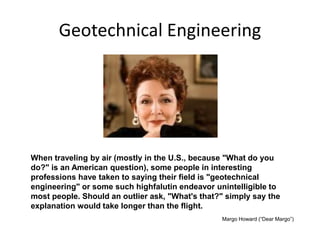Some Known Facts About Geotheta.
Wiki Article
Fascination About Geotheta
Table of ContentsWhat Does Geotheta Mean?Indicators on Geotheta You Should Know5 Easy Facts About Geotheta DescribedGeotheta for Dummies5 Simple Techniques For Geotheta

They conduct website examinations, collect examples, do research laboratory tests, and assess data to examine the suitability of the ground for building and construction projects - Engineer of Record. Based on their searchings for, geotechnical engineers provide referrals for structure style, incline stability, keeping structures, and mitigation of geotechnical threats. They team up with various other experts, such as designers, structural designers, and construction groups, to ensure that geotechnical considerations are incorporated right into the overall task design and execution
By analyzing the actions and residential or commercial properties of dirt and rock, they can identify prospective geotechnical dangers such as landslides, soil settlement, or slope instability. Their know-how helps stop failures or mishaps that might threaten lives and residential property. Here are some detailed tasks and obligations of a geotechnical engineer: Site Examination: Geotechnical engineers conduct site examinations to collect information on subsurface problems.
They translate the data to understand the residential or commercial properties and behavior of the soil and rock, including their strength, permeability, compaction features, and groundwater problems. Geotechnical Evaluation and Design: Geotechnical designers examine the data accumulated throughout site investigations to analyze the security and viability of the site for building and construction tasks. They carry out geotechnical computations and modeling to evaluate variables such as birthing capability, settlement, slope stability, lateral earth pressures, and groundwater circulation.
The Greatest Guide To Geotheta
Structure Style: Geotechnical designers play a critical duty in developing foundations that can securely support the desired structure. They examine the soil problems and load demands to determine the appropriate foundation kind, such as shallow structures (e.g., footings), deep foundations (e.g (https://www.abnewswire.com/companyname/geotheta.com_139529.html#detail-tab)., stacks), or specialized strategies like soil improvement. They consider variables such as settlement limits, bearing capability, and soil-structure interaction to create optimal structure layoutsThey examine construction strategies, screen website tasks, and carry out area inspections to validate that the layout suggestions are followed. If unexpected geotechnical problems develop, they evaluate the scenario and give recommendations for removal or adjustments to the design. Danger Assessment and Mitigation: Geotechnical engineers analyze geotechnical threats and threats related to the project website, such as landslides, liquefaction, or soil erosion.

Partnership and Interaction: Geotechnical designers function carefully with various other specialists associated with a job, such as engineers, architectural designers, and building and construction teams. Efficient communication and cooperation are necessary to incorporate geotechnical factors to consider right into the total project style and building procedure. Geotechnical designers supply technological proficiency, response inquiries, and make certain that geotechnical demands are met.
Not known Facts About Geotheta
Right here are some kinds of geotechnical engineers: Structure Engineer: Foundation designers focus on developing and analyzing foundations for structures. They assess the soil problems, load demands, and website attributes to figure out the most suitable structure kind and layout, such as shallow foundations, deep foundations, or specialized strategies like pile structures.They evaluate the factors influencing incline stability, such as soil residential or commercial properties, groundwater conditions, and slope geometry, and create approaches to stop slope failures and minimize dangers. Quake Designer: Quake designers concentrate on examining and designing frameworks to endure seismic forces. They assess the seismic risk of a site, assess soil liquefaction potential, and create seismic design criteria to guarantee the safety and security and durability of structures during quakes.
They perform area testing, gather samples, and analyze the collected information to define the dirt residential properties, geologic developments, and groundwater conditions at a site. Geotechnical Instrumentation Designer: Geotechnical instrumentation designers concentrate on tracking and gauging the habits of dirt, rock, and structures. They mount and maintain instrumentation systems that keep track of factors such as dirt settlement, groundwater degrees, slope motions, and architectural variations to examine efficiency and supply early warnings of prospective problems.
The Only Guide to Geotheta
They conduct tests such as triaxial tests, consolidation examinations, direct shear tests, and permeability examinations to gather data for geotechnical evaluation and style. Geosynthetics Engineer: Geosynthetics engineers specialize in the design and application of geosynthetic products, such as geotextiles, geogrids, and geomembranes. They make use of these products to enhance soil stability, reinforce slopes, supply water drainage solutions, and control disintegration.They often tend to be investigative individuals, which indicates they're intellectual, reflective, and curious. They are curious, systematic, sensible, analytical, and logical. Some of them are additionally social, implying they're kind, generous, participating, client, caring, practical, empathetic, sensible, and pleasant - Consulting Engineer.
In the office setting, geotechnical engineers make use of specialized software application tools to perform calculations, create designs, and examine data. They prepare reports, review job her comment is here requirements, connect with customers and employee, and coordinate job tasks. The workplace setup provides a favorable setting for research study, analysis, and collaboration with other experts entailed in the project.
All about Geotheta
They frequently check out task websites to carry out site examinations, analyze geotechnical problems, and collect information for analysis. These gos to entail taking a trip to various places, often in remote or difficult terrains. Geotechnical engineers may do dirt tasting, conduct examinations, and display construction activities to ensure that the geotechnical aspects of the project are being executed appropriately.Geotechnical designers also work in specialized geotechnical research laboratories. Geotechnical research laboratory designers work extensively in these settings, dealing with screening devices, running tools, and taping data.
Report this wiki page